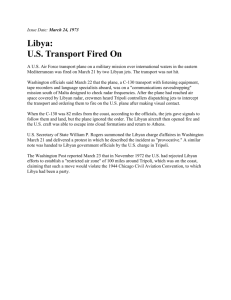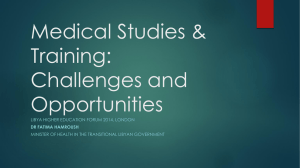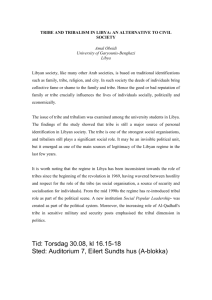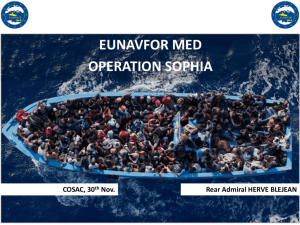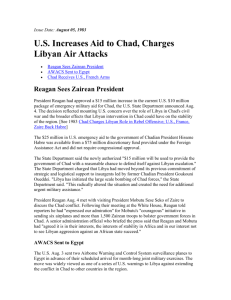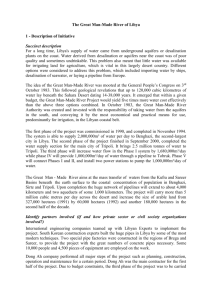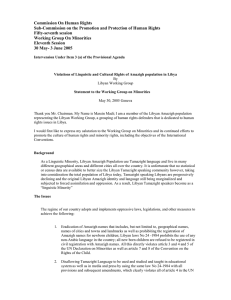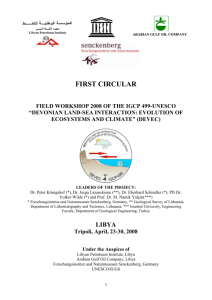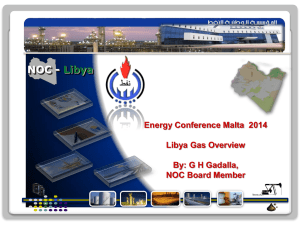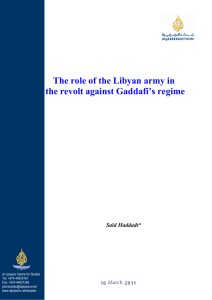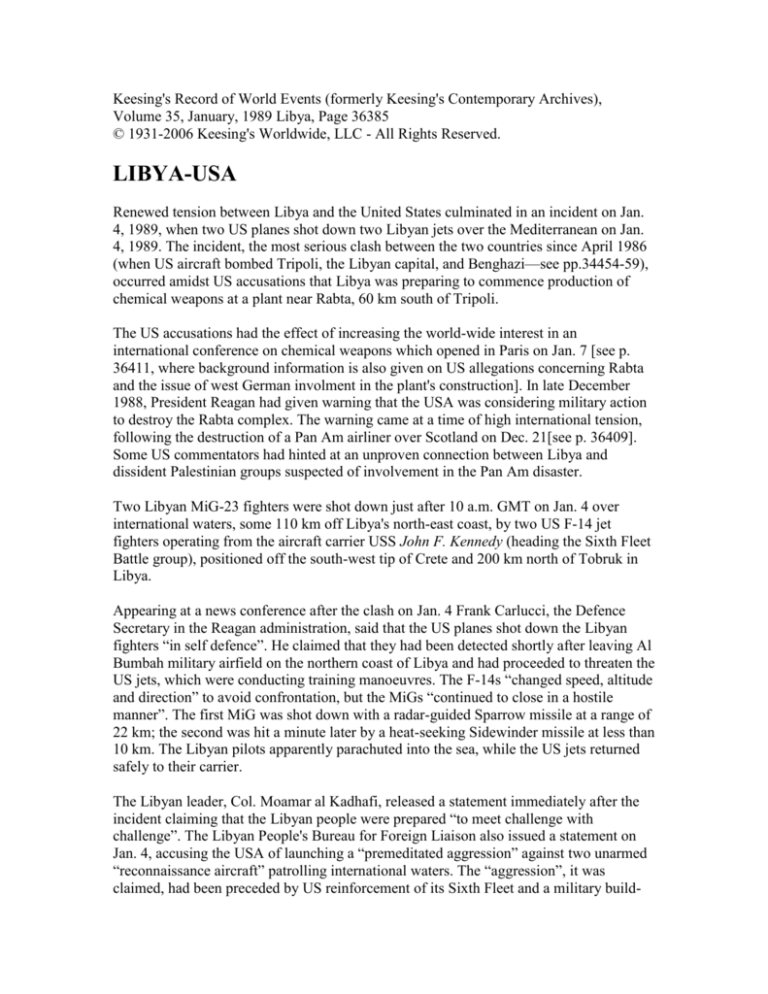
Keesing's Record of World Events (formerly Keesing's Contemporary Archives),
Volume 35, January, 1989 Libya, Page 36385
© 1931-2006 Keesing's Worldwide, LLC - All Rights Reserved.
LIBYA-USA
Renewed tension between Libya and the United States culminated in an incident on Jan.
4, 1989, when two US planes shot down two Libyan jets over the Mediterranean on Jan.
4, 1989. The incident, the most serious clash between the two countries since April 1986
(when US aircraft bombed Tripoli, the Libyan capital, and Benghazi—see pp.34454-59),
occurred amidst US accusations that Libya was preparing to commence production of
chemical weapons at a plant near Rabta, 60 km south of Tripoli.
The US accusations had the effect of increasing the world-wide interest in an
international conference on chemical weapons which opened in Paris on Jan. 7 [see p.
36411, where background information is also given on US allegations concerning Rabta
and the issue of west German involment in the plant's construction]. In late December
1988, President Reagan had given warning that the USA was considering military action
to destroy the Rabta complex. The warning came at a time of high international tension,
following the destruction of a Pan Am airliner over Scotland on Dec. 21[see p. 36409].
Some US commentators had hinted at an unproven connection between Libya and
dissident Palestinian groups suspected of involvement in the Pan Am disaster.
Two Libyan MiG-23 fighters were shot down just after 10 a.m. GMT on Jan. 4 over
international waters, some 110 km off Libya's north-east coast, by two US F-14 jet
fighters operating from the aircraft carrier USS John F. Kennedy (heading the Sixth Fleet
Battle group), positioned off the south-west tip of Crete and 200 km north of Tobruk in
Libya.
Appearing at a news conference after the clash on Jan. 4 Frank Carlucci, the Defence
Secretary in the Reagan administration, said that the US planes shot down the Libyan
fighters “in self defence”. He claimed that they had been detected shortly after leaving Al
Bumbah military airfield on the northern coast of Libya and had proceeded to threaten the
US jets, which were conducting training manoeuvres. The F-14s “changed speed, altitude
and direction” to avoid confrontation, but the MiGs “continued to close in a hostile
manner”. The first MiG was shot down with a radar-guided Sparrow missile at a range of
22 km; the second was hit a minute later by a heat-seeking Sidewinder missile at less than
10 km. The Libyan pilots apparently parachuted into the sea, while the US jets returned
safely to their carrier.
The Libyan leader, Col. Moamar al Kadhafi, released a statement immediately after the
incident claiming that the Libyan people were prepared “to meet challenge with
challenge”. The Libyan People's Bureau for Foreign Liaison also issued a statement on
Jan. 4, accusing the USA of launching a “premeditated aggression” against two unarmed
“reconnaissance aircraft” patrolling international waters. The “aggression”, it was
claimed, had been preceded by US reinforcement of its Sixth Fleet and a military build-
up in the Mediterranean. The Bureau called for an emergency meeting of the UN security
Council to discuss the incident.
The reaction of US allies to the incident was generally muted, with some countries
expressing concern that the clash was a possible precursor for a US attack on the Rabta
complex. The Arab states rallied to Libya's defence, with statements critical of the US
action being issued by individual countries and also by the Arab League (which held an
emergency meeting in Tunisia on Jan. 12 to discuss the “American aggression”) and the
Islamic Conference Organization.
British support for the US action was qualified by a statement warning against the
launching of an “illegal” attack on Rabta. Nevertheless, the British government claimed
to have gathered “independent confirmation” of Libya's intention to commence chemical
weapons production. According to The Times of Jan. 6 the UK had also vetoed a
European Communities (EC) statement which failed to support the US version of events.
The Soviet Union accused the USA of “state terrorism” and “political adventurism” in its
first comment on the incident, issued on Jan. 5.
An acrimonious debate on the incident was held in the UN security Council chamber on
Jan. 6. Gen. Vernon Walters, the US permanent representative at the UN, presented a
series of photographs purporting to show that the Libyan jets had been armed with air-toair missiles. A US video recording released the previous day claimed to show that at least
one of the Libyan jets was armed.) Libya's ambassador to the UN, Ali Muntasser,
described the photographs as “fakes”. The Soviet ambassador, Alexander Belongov, said
it was “absolutely immaterial” whether or not the Libyan jets were armed and that he was
“outraged” by the US contention that “if a foreign military aeroplane is armed it is a
provocation to fire”.
When the UN security Council met on Jan. 11, a draft resolution deploring the US action,
and calling on the USA to suspend its military manoeuvres off the Libyan coast, was
vetoed by the USA, France and the UK.
Aug. 19, 1981. Two Libyan Su-22 jets over Gulf of Sirte (Sidra) shot down by US F-14
jets during US naval manoeuvres [see p. 31181-83].
March 24–25, 1986. Alleged Libyan attack on US ships operating in Gulf of Sirte; US
retaliates against Libyan patrol boats and shore batteries [see p. 34454-55].
April 15, 1986. US F-111 bombers based in Britain carry out bombing raids on targets in
Tripoli and Benghazi, resulting in large numbers of civilian casualties [see p. 34454-59].
Jan. 4, 1989. Two US F-14 jets shoot down two Libyan MiG-23 fighters some 110 km
off the Libyan coast.
© 1931- 2008 Keesing's Worldwide, LLC - All Rights Reserved.

